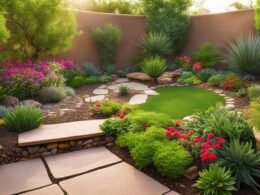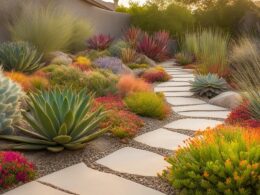In today’s world, where environmental awareness is on the rise, it is crucial to find eco-friendly solutions that conserve water and nourish your plants. As a gardener, you have the power to make a positive impact on the environment by embracing sustainable watering systems for your gardens.
Key Takeaways:
- Implementing sustainable watering systems in your garden helps conserve water and promote a healthier planet.
- Eco-friendly solutions not only benefit the environment but also nourish your plants and improve their overall health.
- By adopting water-wise techniques, you can optimize water use, reduce costs, and create a more sustainable landscape.
- Consulting with a local landscape professional can provide personalized advice on the best sustainable practices for your specific garden.
- Embracing sustainable watering systems is a responsible choice that contributes to the overall well-being of your garden and the planet.
Water Wisdom and Sustainability
Water sustainability is a crucial aspect of responsible gardening. By utilizing wise watering practices, you can reduce wastefulness, improve water quality, and design your home to be more sustainable. Wise watering use involves understanding the needs of your plants and providing them with the right amount of water, at the right time, and in the right way.
One way to reduce wastefulness is by avoiding overwatering. Many gardeners tend to water their plants excessively, thinking it will benefit them. However, this can lead to water runoff, nutrient leaching, and unnecessary water consumption. By watering your plants only when needed and providing moderate amounts of water, you can promote healthier plant growth while conserving water resources.
Another aspect of water sustainability is improving water quality. When using traditional watering methods, such as sprinklers or overhead watering, it’s common for water to come into contact with leaves and foliage. This can potentially promote fungal growth and lead to various plant diseases. By adopting methods that deliver water directly to the roots, such as drip irrigation or soaker hoses, you can reduce the risk of fungal diseases and improve water quality.
“Using sustainable watering practices not only benefits the environment but also helps you design a home that harmonizes with its surroundings.”
Table: Comparison of Traditional Watering Methods and Sustainable Watering Solutions
| Traditional Watering Methods | Sustainable Watering Solutions |
|---|---|
| Overhead sprinklers | Drip irrigation |
| Hand watering with a hose | Soaker hoses |
| Watering cans | Watering at the base of plants |
| Automatic sprinkler systems | Smart irrigation controllers |
Designing homes with water sustainability in mind is essential. By incorporating elements like rainwater harvesting systems, permeable pathways, and native plant landscaping, you can create a more sustainable and water-efficient environment.
Resources:
- WaterSense: The U.S. Environmental Protection Agency’s resource for finding water-saving products and practices for sustainable gardening.
- The Sustainable Gardening Blog: A blog dedicated to providing tips and inspiration for sustainable gardening practices.
- Native Plant Society: A nonprofit organization that promotes the use of native plants in landscaping for water conservation and ecological benefits.
Sustainable Landscapes
Creating a sustainable landscape involves turning your yard into a sustainable oasis with the help of native plants. Native plants have adapted to the local climate, soil, and insects, making them hardy and low-maintenance. By using native plants, you can conserve water and create a sustainable garden that thrives in your specific region. Additionally, native plants provide important habitat for local wildlife, promoting biodiversity and ecological balance.
When designing your sustainable landscape, consider incorporating plant species that are well-suited to your climate. By choosing plants that are adapted to local conditions, they will require less water, fertilizer, and pest control, resulting in a low-maintenance garden that saves both time and resources. Native grasses, wildflowers, and shrubs are excellent choices for sustainable landscapes, as they are naturally adapted to the local environment.
In addition to using native plants, there are other design elements that can further enhance the sustainability of your landscape. For example, incorporating mulch around plants can help retain moisture in the soil, reduce weed growth, and improve soil fertility. Rain gardens are another sustainable landscaping feature that can help capture and filter rainwater runoff, reducing the strain on local water resources.
Benefits of Sustainable Landscapes:
- Conserves water
- Reduces maintenance requirements
- Promotes biodiversity and ecological balance
- Supports local wildlife
- Enhances soil health and fertility
- Improves air quality
By creating a sustainable landscape, you can not only beautify your outdoor space but also contribute to a more environmentally friendly and resilient community. Sustainable landscapes have numerous benefits and can be tailored to suit the unique needs of your region. Embrace the versatility of native plants and incorporate sustainable design principles to create a beautiful, low-maintenance garden that conserves water and fosters a healthier ecosystem.
Rainwater Collection: A Sustainable Solution for Water Conservation
When it comes to water conservation in your garden, one of the simplest and most effective solutions is rainwater collection. By harnessing the power of nature, you can save water, prevent runoff, and promote natural water processing. It’s a win-win for both your garden and the environment.
Rain barrels are a popular method for collecting rainwater from rooftops. They provide a free and chemical-free source of water that can be used to nourish your plants. With a simple setup and maintenance, rain barrels can significantly reduce water bills and minimize reliance on municipal water supplies.
Not only does rainwater collection save water, but it also helps to prevent runoff. When rainwater flows off your property, it picks up pollutants and carries them into nearby water sources. By collecting rainwater in barrels, you are preventing this polluted runoff from entering the ecosystem, thus protecting local water sources and promoting a healthier environment.
| Benefits of Rainwater Collection | Methods of Rainwater Collection |
|---|---|
|
|
“Rainwater collection is a simple and effective way to conserve water and prevent runoff. It’s an eco-friendly practice that benefits both your garden and the environment.” – Sustainable Gardening Expert
By implementing rainwater collection systems in your garden, you are taking a proactive step towards sustainable water use. You’ll not only be saving water and reducing your environmental impact, but you’ll also be creating a more self-sufficient and resilient garden. Embrace rainwater collection and do your part in conserving water resources for a greener future.
Install Permeable Pathways
When it comes to managing water runoff in your garden, installing permeable pathways is a smart and eco-friendly solution. Unlike traditional concrete or asphalt pathways that cause water to run off, permeable pathways allow rain and surface water to be absorbed back into the ground, promoting groundwater recharge and reducing the strain on local water sources.
Permeable pathways offer an excellent alternative to conventional hardscaping materials. By using crushed stone or mulch as the base material, water can easily penetrate the surface and be gradually absorbed into the soil. If you prefer a more solid surface, there are also permeable pavers available that allow water to seep through the gaps between them.
Not only do permeable pathways minimize water runoff, but they also offer aesthetic benefits. The natural look of crushed stone or mulch adds a rustic charm to your garden, while permeable pavers come in various shapes, colors, and patterns, allowing you to create a unique and visually appealing pathway design.
| Benefits of Permeable Pathways | Benefits of Traditional Concrete/Asphalt Pathways |
|---|---|
| – Reduce water runoff | – Provide a solid surface |
| – Promote groundwater recharge | – Require minimal maintenance |
| – Prevent erosion | – Offer long-lasting durability |
| – Allow for better water infiltration | – Can be easily cleaned |
By installing permeable pathways in your garden, you can effectively manage water runoff, recharge groundwater, and create a more sustainable outdoor space. Whether you choose crushed stone, mulch, or permeable pavers, these alternatives to traditional concrete or asphalt pathways provide both functional and aesthetic benefits, making them an ideal choice for any eco-conscious gardener.
Help the Plants Help Themselves
Companion planting is a widely used technique in gardening where certain combinations of plants are grown together for mutual benefits. By strategically planting compatible species, you can naturally enhance the health and productivity of your garden. One of the key advantages of companion planting is its positive impact on nutrient uptake. Certain plants have the ability to improve the soil quality by fixing nitrogen or increasing nutrient availability, benefiting neighboring plants and promoting overall plant health.
Another benefit of companion planting is its effectiveness in pest management. Some plant combinations work together to repel pests or attract beneficial insects that prey on harmful pests. For example, planting marigolds with tomatoes is believed to repel nematodes and other pests that commonly affect tomato plants. By incorporating companion planting strategies in your garden, you can minimize the use of pesticides and create a balanced ecosystem that supports natural pest control.
Furthermore, companion planting can also help improve pollination rates and increase crop yields. Certain plants, such as flowers, attract bees and other pollinators, which play a crucial role in the reproduction of many fruits and vegetables. By including these companion plants in your garden, you can increase the likelihood of successful pollination and enjoy a bountiful harvest.
Companion Planting Pairings
Here are some popular companion planting pairings that have been proven effective:
- Tomatoes and basil: Basil repels pests that commonly affect tomatoes, such as aphids and whiteflies.
- Corn, beans, and squash (the Three Sisters): Corn provides support for the beans to climb, while the beans fix nitrogen in the soil, benefiting the corn and squash.
- Cabbage and dill: Dill attracts beneficial insects that prey on cabbage pests, such as cabbage worms.
- Carrots and onions: Onions repel carrot flies, which are a common pest of carrots.
By practicing companion planting in your garden, you can maximize the benefits of each plant and create a thriving, self-sustaining ecosystem that promotes plant health, pest management, and nutrient uptake.
| Plant Pairing | Benefit |
|---|---|
| Tomatoes and basil | Basil repels pests like aphids and whiteflies that commonly affect tomatoes. |
| Corn, beans, and squash (Three Sisters) | Corn provides support for the beans to climb, while beans fix nitrogen in the soil, benefiting the corn and squash. |
| Cabbage and dill | Dill attracts beneficial insects that prey on cabbage pests, such as cabbage worms. |
| Carrots and onions | Onions repel carrot flies, which are a common pest of carrots. |
Intensive Planting
Intensive planting is a strategic technique that involves placing plants closer together to maximize space and create a support system among them. This method offers various benefits, including efficient water conservation and effective weed control. By reducing the space between plants, you create a microclimate that reduces evaporation and shades the soil, helping to retain moisture. Additionally, the dense foliage helps to suppress weed growth, minimizing competition for water and nutrients.
When implementing intensive planting, proper plant spacing is crucial. Ensure that the leaves of neighboring plants touch but do not overcrowd each other’s roots. This arrangement encourages healthy root development and enhances the plants’ ability to access water and nutrients from the soil. With their roots intertwined, the plants also provide natural support to each other, reducing the need for additional structures or stakes.
To further optimize water conservation, consider incorporating a drip irrigation system or soaker hoses into your garden. These water delivery methods direct water straight to the root zone, minimizing evaporation and ensuring that plants receive the necessary moisture. By adopting intensive planting techniques and utilizing efficient watering systems, you can create a thriving, water-wise garden that requires less maintenance and fosters a healthy ecosystem.
Benefits of Intensive Planting:
- Optimizes space utilization
- Efficient water conservation
- Effective weed control
- Promotes healthy root development
- Natural support system among plants
Deliver Water Directly to the Roots
When it comes to watering your plants, delivering water directly to the roots offers several benefits. By targeting the roots, you can reduce water loss through evaporation, prevent fungal growth, and minimize the risk of sunburned leaves. There are two effective methods for achieving this: soaker hoses and drip irrigation systems.
Soaker hoses are designed with tiny holes that allow water to slowly seep into the soil, directly irrigating the root zone. This method ensures that the water is delivered precisely where it’s needed, reducing wastage and maximizing efficiency. Drip irrigation systems, on the other hand, utilize perforated tubing and valves to provide controlled moisture to the plant roots. Both methods offer a more efficient and cost-effective alternative to traditional overhead sprinklers.
By watering at the roots, you can also reduce the risk of fungal diseases. This is because wet foliage provides an ideal environment for fungi to thrive. When water is delivered directly to the roots, the leaves remain dry, minimizing the chance of fungal growth. Additionally, watering at the roots can help cut down on water costs, as less water is lost to evaporation and runoff.
The Benefits of Watering at the Roots:
- Reduces water loss through evaporation
- Prevents fungal growth on leaves
- Minimizes the risk of sunburned leaves
- Maximizes water efficiency and reduces costs
Table: Comparing Soaker Hoses and Drip Irrigation Systems
| Method | Advantages | Disadvantages |
|---|---|---|
| Soaker Hoses |
|
|
| Drip Irrigation Systems |
|
|
By delivering water directly to the roots using soaker hoses or drip irrigation systems, you can ensure that your plants receive the optimal amount of water while minimizing waste. This not only promotes water conservation but also helps maintain the health and vitality of your garden. Consider implementing these methods in your watering routine to reduce evaporation, prevent fungal growth, and save on watering costs.
Sustainable Watering Solutions for Gardens
When it comes to creating a sustainable garden that optimizes water use, consulting with landscape professionals can provide valuable insights and expertise. These experts specialize in water-wise techniques and can offer personalized advice on how to implement low-water use strategies in your garden. Sustainable watering solutions are essential for conserving water and promoting eco-friendly gardening practices.
A landscape professional can help you evaluate your garden’s specific needs and recommend the most suitable watering methods. They can guide you on using efficient irrigation systems, such as drip irrigation or soaker hoses, which deliver water directly to the plant’s roots while minimizing evaporation and runoff. By implementing these water-wise techniques, you can reduce water usage and achieve optimal plant health.
Furthermore, landscape professionals can assist in selecting the right plant species for your garden. By choosing drought-tolerant and native plants, you can create a low-water use landscape that requires minimal irrigation. These plants have adapted to the local climate conditions and are better suited to thrive with less water, reducing the need for frequent watering. A landscape professional can help you design a garden that is both visually appealing and environmentally sustainable.
Overall, working with landscape professionals is a wise investment for any garden enthusiast seeking sustainable watering solutions. Their expertise in water-wise techniques, knowledge of low-water use plant species, and experience in designing eco-friendly landscapes can help you create a beautiful and water-efficient garden. By embracing their guidance and implementing sustainable practices, you can contribute to water conservation efforts while enjoying a thriving and environmentally friendly garden.
Sustainable Watering Solutions for Gardens
Creating a greener garden goes beyond simply planting eco-friendly species. It also involves implementing sustainable watering practices that promote water conservation and support the health of your plants. One important aspect of sustainable gardening is the use of eco-friendly sprinkler systems. These systems are designed to optimize water use and minimize waste, making them an excellent choice for gardeners looking to reduce their environmental impact.
By investing in an eco-friendly sprinkler system, you can effectively manage water consumption in your garden. These systems are designed to distribute water evenly and efficiently, ensuring that plants receive the necessary moisture without excessive runoff or evaporation. This not only helps to conserve water but also promotes healthy root development and plant growth. With advanced features like adjustable spray patterns and timers, eco-friendly sprinkler systems allow you to tailor your watering schedule to meet the specific needs of your garden.
“The use of eco-friendly sprinkler systems can significantly contribute to water conservation in gardens, ensuring that this precious resource is utilized efficiently.” – Sustainable Gardening Expert
Benefits of Eco-Friendly Sprinkler Systems
Switching to eco-friendly sprinkler systems offers several benefits for both gardeners and the environment. Here are some key advantages:
- Water Conservation: Eco-friendly sprinkler systems are designed to minimize water waste, helping you reduce your overall water consumption and lower your water bills.
- Plant Health: These systems deliver water directly to the roots, promoting healthier and more resilient plants. By providing the right amount of moisture at the right time, you can prevent overwatering or underwatering, leading to stronger and more vibrant plants.
- Environmental Impact: By conserving water and reducing runoff, eco-friendly sprinkler systems play a vital role in preserving local water sources, protecting ecosystems, and mitigating the effects of drought.
- Convenience: With features like timers and sensors, these systems offer convenience and flexibility. You can set a watering schedule that aligns with your garden’s needs, ensuring that your plants receive consistent care even when you’re not around.
| Watering Method | Water Conservation | Plant Health | Environmental Impact | Convenience |
|---|---|---|---|---|
| Traditional Sprinklers | High water usage and wasteful runoff | Inconsistent watering, potential for over or underwatering | High water consumption, contributes to water scarcity | Manual operation required |
| Eco-Friendly Sprinkler Systems | Minimized water waste, efficient distribution | Precise watering at the root level, healthier plants | Conserves water, protects local water sources | Automated scheduling and control options |
By embracing eco-friendly sprinkler systems and adopting sustainable watering practices, you can contribute to the overall sustainability of your garden. These systems not only conserve water but also ensure that your plants receive the necessary care for optimal growth and development. So, make the switch today and enjoy the benefits of a greener and more eco-friendly garden.
Conclusion
In conclusion, sustainable watering systems are a crucial component of responsible water use in eco-friendly gardening. By embracing sustainable practices and opting for eco-friendly sprinkler systems, you can actively contribute to the sustainability of your garden and the environment as a whole.
Implementing sustainable watering techniques not only helps conserve water but also reduces costs and promotes the health of your plants. By making responsible choices in your watering methods, you can create a greener garden that thrives while minimizing water waste.
It is important to remember that sustainability should be at the forefront of your gardening practices. By prioritizing eco-friendly gardening, you can contribute to the well-being of our planet and ensure the continued availability of valuable water resources.
So, as you tend to your garden, make sure to prioritize sustainable watering, responsible water use, and eco-friendly gardening practices. By doing so, you are not only creating a beautiful and thriving garden but also playing your part in building a more sustainable future.
What Sustainable Watering Systems Would Work Best for a Drought-Tolerant Garden?
Drip irrigation emerges as an ideal solution for a droughttolerant perennial garden, targeting the root zones and minimizing waste. Such a system ensures that plants with low water requirements thrive, conserving this precious resource while maintaining a verdant oasis amidst arid conditions.
FAQ
What is water sustainability?
Water sustainability refers to the continual supply of clean water for human uses and other living things.
Why is native planting important for water conservation?
Native plants have adapted to the local climate, soil, and insects, making them hardy and low-maintenance. By using native plants, gardeners can conserve water and create a sustainable garden that thrives in their specific region.
How can rainwater be collected for gardening purposes?
Rain barrels can be used to collect rainwater from roofs, providing a free and chemical-free source of water for plants.
What are permeable pathways and how do they help with water runoff?
Permeable pathways allow rain and surface water runoff to be returned to the groundwater, minimizing water runoff and recharging groundwater. Crushed stone, mulch, or permeable pavers can be used instead of concrete or asphalt to create permeable paths.
What is companion planting and how does it benefit a garden?
Companion planting is a technique where certain combinations of plants are grown together for mutual benefits, such as nutrient uptake, attracting pollinators, and improving pest management.
How does intensive planting help with water conservation?
Intensive planting involves placing plants closer together to support each other, send down deeper roots, and crowd out weeds. This method conserves water and creates a support system among plants.
What are some effective methods for delivering water directly to plant roots?
Soaker hoses and drip irrigation systems are two effective methods for delivering water directly to plant roots. Soaker hoses slowly seep water into the soil through tiny holes, while drip irrigation systems involve perforated tubing and valves.
Where can I find personalized advice on water-wise techniques for my garden?
Consulting with a local landscape professional is recommended. They can provide personalized advice and suggestions on which techniques would work well in your particular garden.
What are the benefits of using eco-friendly sprinkler systems?
Eco-friendly sprinkler systems offer benefits such as water conservation, cost savings, optimal plant health, and reduced runoff.
How can sustainable watering systems contribute to water conservation and plant health?
By using sustainable practices and implementing eco-friendly sprinkler systems, gardeners can conserve water, reduce costs, and promote the health of their plants.














